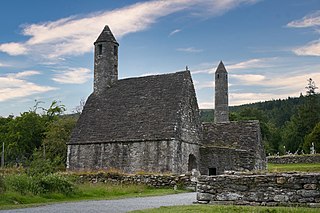
Glendalough is a glacial valley in County Wicklow, Ireland, renowned for an Early Medieval monastic settlement founded in the 6th century by St Kevin. From 1825 to 1957, the head of the Glendalough Valley was the site of a galena lead mine. Glendalough is also a recreational area for picnics, for walking along networks of maintained trails of varying difficulty, and also for rock-climbing.

Irish round towers are early mediaeval stone towers of a type found mainly in Ireland, with two in Scotland and one on the Isle of Man. As their name Cloigtheach indicates, they were originally bell towers, though they may have been later used for additional purposes.
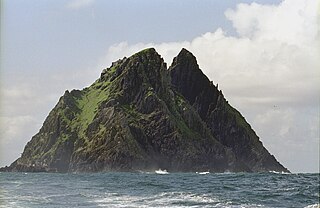
Skellig Michael, also called Great Skellig, is a twin-pinnacled crag 11.6 kilometres (7.2 mi) west of the Iveragh Peninsula in County Kerry, Ireland. The island is named after the archangel Michael, with "Skellig" derived from the Irish language word sceilig, meaning a splinter of stone. Its twin island, Little Skellig, is smaller and inaccessible. The two islands rose c. 374–360 million years ago during a period of mountain formation, along with the MacGillycuddy's Reeks mountain range. Later, they were separated from the mainland by rising water levels.
Saint Fiacc was a poet, the chief bishop of Leinster, and founder of two churches.
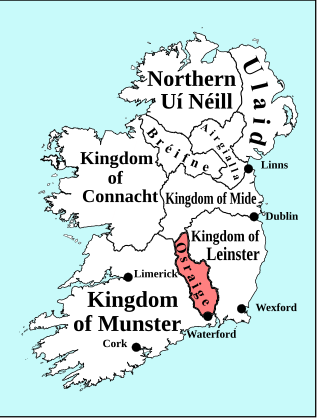
Osraige or Osraighe, Osraí, anglicized as Ossory, was a medieval Irish kingdom comprising what is now County Kilkenny and western County Laois, corresponding to the Diocese of Ossory. The home of the Osraige people, it existed from around the first century until the Norman invasion of Ireland in the 12th century. It was ruled by the Dál Birn dynasty, whose medieval descendants assumed the surname Mac Giolla Phádraig.
Killeshin is a village in County Laois, Ireland on the R430 regional road. Killeshin is a small rural community situated five kilometres west of Carlow town and overlooks the picturesque Barrow Valley. The church at the foot of the Killeshin hills is the site of an early Christian monastery.
Sletty, Sleaty, or Slatey, is a civil parish in County Laois, Ireland. It is situated some 2 km north-north-west of the town of Carlow. It was once the see of a bishopric, founded by Saint Fiacc in the fifth century, but this was later transferred to Leighlin. It was at Sletty, according to James Joyce in his novel Ulysses, that Cormac mac Airt 'suffocated by imperfect deglutition of aliment', i.e. that he choked on a fishbone.
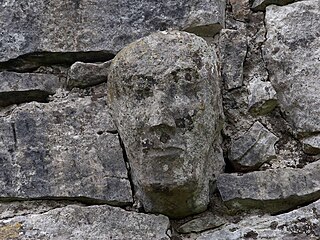
Temple Cronan is a ruined medieval oratory or chapel built near a holy well in the Burren, County Clare, Ireland. The current building apparently dates from the 12th and 15th centuries, although it may partly incorporate earlier buildings or some of the masonry thereof. It may have been the site of an early Christian monastery. Temple Cronan is located in the civil parish of Carran, eight miles from Corofin and about sixteen miles from Ennis.
Ballyhide is a rural townland and village in the extreme south eastern corner of County Laois, Ireland at the border with County Carlow. The nearest urban centre is Carlow town which is 3 kilometres to the north east. It is located in the Luggacurren Local Electoral District.
St. Kieran's Church is a medieval church and National Monument located in Errill, County Laois, Ireland.

Killeshin Church is a 12th-century Romanesque church and National Monument located in County Laois, Ireland.

Clondalkin Round Tower is an Irish round tower or cloigtheach founded by Saint Mochua, also known as Saint Cronan, and located in Clondalkin, South Dublin, Ireland. It is now a National Monument of Ireland. It's also become a museum that houses a cafe.
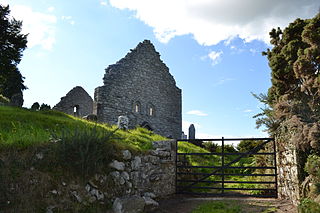
Aghowle Church is a medieval church and National Monument in County Wicklow, Ireland. It was one of the largest rural parish churches of its era. Aghowle is also a civil parish in the ancient barony of Shillelagh.

Ullard Church is a medieval church and National Monument in County Kilkenny, Ireland.

Kilkieran High Crosses are a group of high crosses which form a National Monument in County Kilkenny, Ireland.

Dromiskin Monastery is a medieval monastery and National Monument located in Dromiskin, County Louth in Ireland.

Mungret Abbey is a medieval friary and National Monument located near Mungret in County Limerick, Ireland.

Kilbennen or Kilbannon is a medieval ecclesiastical site and National Monument located in County Galway, Ireland.

The Priory of Saint Mary, Clontuskert-Hy-Many, also called Clontuskert Abbey, is a medieval Augustinian priory and National Monument located in County Galway, Ireland.

Dísert Óengusa is a medieval hermitage and National Monument located in County Limerick, Ireland.
















